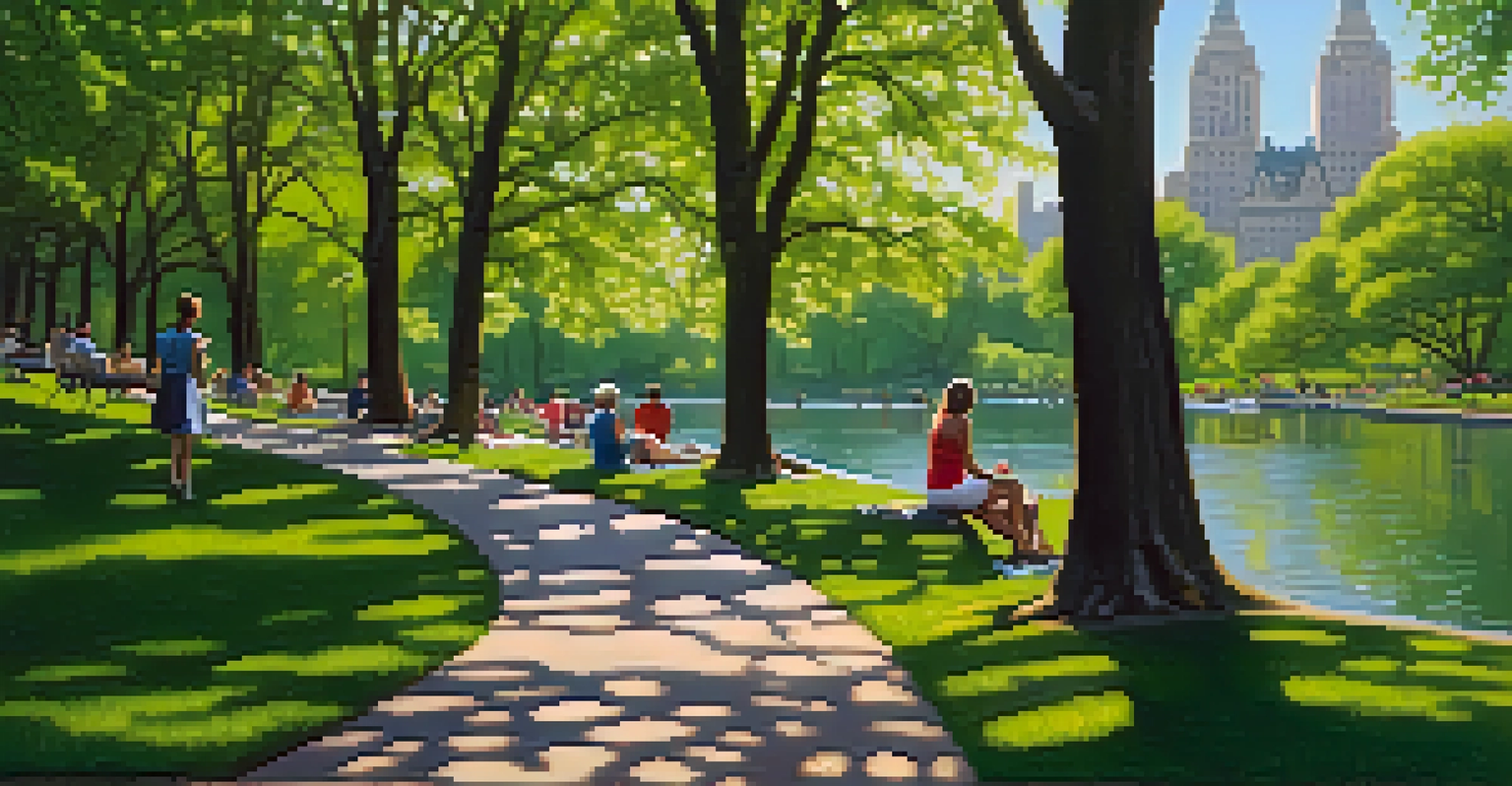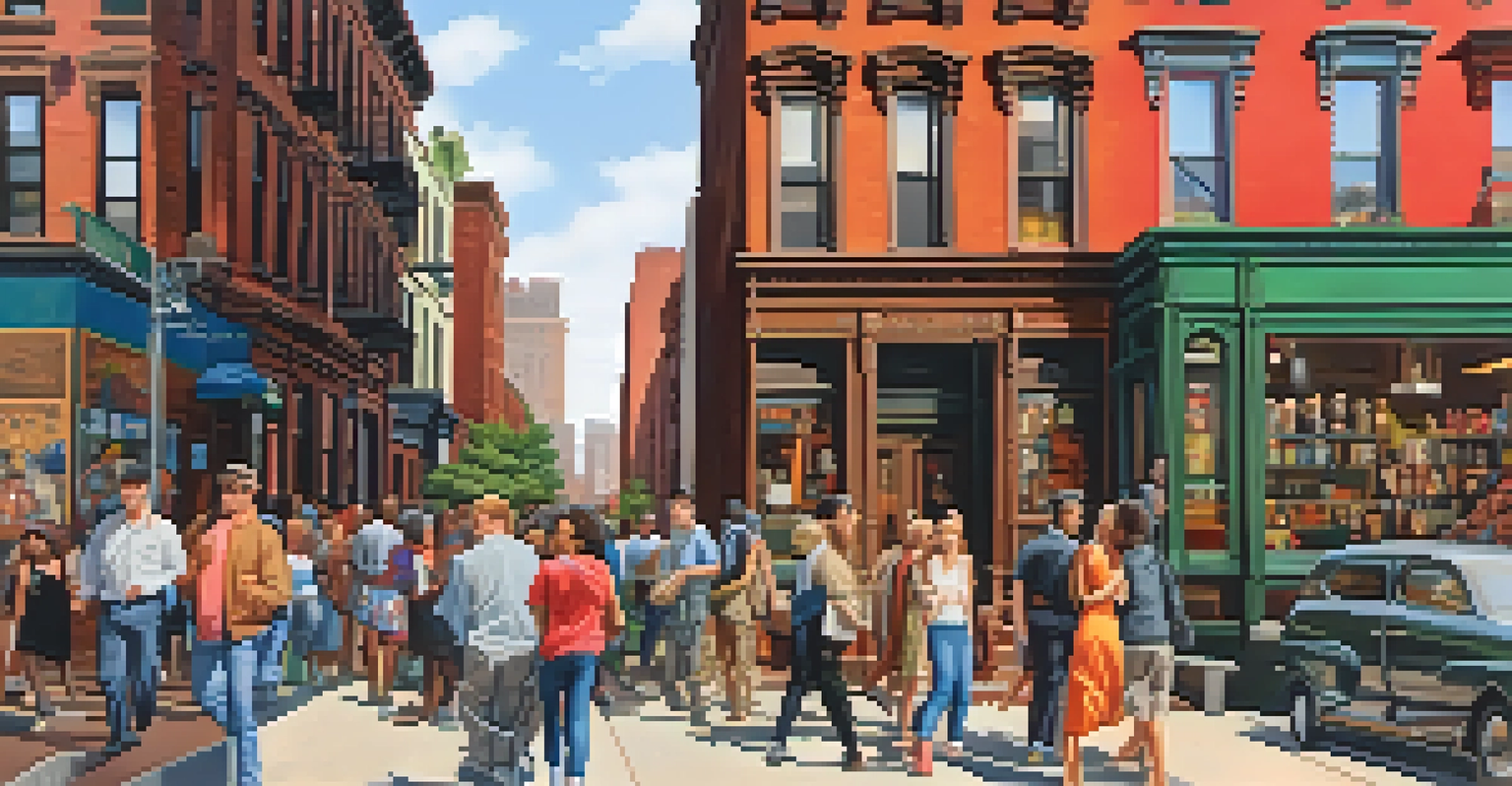Urban Landscapes: New York City and Its Surroundings

The Iconic Skyline of New York City
New York City is renowned for its iconic skyline, a symbol of ambition and creativity. From the towering Empire State Building to the sleek One World Trade Center, these structures define the city's architectural landscape. The skyline is not just a collection of buildings; it tells a story of resilience and innovation, reflecting the spirit of its inhabitants.
New York City is a city that never sleeps, and its skyline is a testament to the ambition and creativity of its people.
As you stroll through Manhattan, the skyline evolves with every turn, showcasing a blend of historic and modern designs. Each neighborhood offers a unique perspective, whether you're admiring the art deco facades of Midtown or the glassy skyscrapers of Hudson Yards. This diversity in architecture invites both locals and tourists to appreciate the city's rich history while embracing contemporary trends.
The skyline truly comes alive at sunset when the buildings are bathed in warm hues, creating a breathtaking view. It’s a perfect backdrop for capturing memories, whether through photographs or simply soaking in the beauty. The New York skyline is more than just a view; it's an experience that leaves a lasting impression on all who visit.
Central Park: A Green Oasis Amidst the Concrete Jungle
Amidst the bustling streets of New York City lies Central Park, a sprawling green oasis that offers a refreshing escape from urban life. Spanning over 840 acres, this park provides a serene environment for relaxation, recreation, and connection with nature. Whether you're jogging along the paths or enjoying a leisurely picnic, Central Park is a beloved retreat for city dwellers and visitors alike.

The park is home to a diverse array of landscapes, from tranquil lakes to lush meadows and wooded areas. Each season brings its own charm, with blooming flowers in spring and vibrant foliage in autumn. This changing scenery creates a dynamic backdrop for countless activities, making Central Park a year-round destination for outdoor enthusiasts.
New York City's Iconic Skyline
The skyline of New York City showcases a blend of historic and modern architecture, symbolizing the city's resilience and creative spirit.
Cultural events, art installations, and concerts frequently take place in the park, enhancing its role as a community hub. Its iconic landmarks, such as Bethesda Terrace and Strawberry Fields, draw people together, fostering a sense of belonging. Central Park is a testament to the importance of green spaces in urban areas, reminding us of nature's vital role in our lives.
Brooklyn: A Borough of Unique Character
Brooklyn is often celebrated for its distinct character, offering a vibrant blend of cultures, arts, and culinary delights. From the historic brownstones of Brooklyn Heights to the trendy shops of Williamsburg, the borough showcases a creative spirit that is palpable in its streets. Each neighborhood has its own unique vibe, making it a favorite destination for exploration.
Central Park is the lungs of New York City, providing fresh air and a breath of life amidst the concrete jungle.
One of Brooklyn's most iconic features is the Brooklyn Bridge, an architectural marvel that connects the borough to Manhattan. Walking across this bridge provides stunning views of the skyline and East River, making it a popular activity for both tourists and locals. The bridge symbolizes the unity between the two boroughs and is a reminder of the city's rich history.
Brooklyn's food scene is another highlight, with an array of eateries that reflect the borough's diversity. From artisanal pizza to international cuisines, there’s something for everyone. This culinary adventure allows visitors to experience the heart and soul of Brooklyn, making it a must-visit destination when exploring urban landscapes.
The Bronx: A Cultural Melting Pot
The Bronx, often overshadowed by its more famous neighbors, is a vibrant cultural melting pot filled with history and creativity. It's home to the birthplace of hip-hop, a genre that has influenced music globally. The Bronx embodies a rich tapestry of cultures, reflected in its neighborhoods, cuisine, and arts, making it an essential part of New York City's urban landscape.
One of the key attractions is the Bronx Zoo, one of the largest metropolitan zoos in the world. It provides a unique opportunity to connect with wildlife while promoting conservation efforts. The zoo, paired with the New York Botanical Garden, creates a space where nature and culture intersect, offering educational experiences for all ages.
Cultural Diversity in Queens
Queens stands out as a culinary paradise, offering a diverse array of international cuisines that reflect its multicultural population.
Cultural institutions, such as the Bronx Museum of the Arts, showcase the work of emerging artists and celebrate the borough's diverse heritage. Events like the Bronx Week highlight local talent and community spirit, inviting everyone to participate in the celebrations. The Bronx is a testament to the power of cultural expression in shaping urban landscapes.
Queens: A Culinary Paradise
Queens is often referred to as the most diverse urban area in the world, and its culinary scene reflects this multiculturalism beautifully. With residents hailing from virtually every corner of the globe, food lovers can embark on a delicious journey through the borough. From authentic dim sum in Flushing to savory arepas in Jackson Heights, Queens is a gastronomic paradise waiting to be explored.
Food festivals and local markets further enhance the culinary experience, allowing visitors to sample a variety of dishes in one place. These events are a celebration of community and culture, showcasing the borough's rich heritage. Each bite tells a story, connecting people through the universal love of food.
Beyond food, Queens offers vibrant street art, parks, and cultural landmarks, making it a dynamic destination for all. The iconic Unisphere in Flushing Meadows-Corona Park serves as a reminder of the borough's role in the 1964 World's Fair, symbolizing global unity. Exploring Queens is not just about tasting different cuisines but also about experiencing the diverse cultures that make up this incredible borough.
Staten Island: The Hidden Gem
Staten Island, often overlooked by visitors, is a hidden gem of New York City waiting to be discovered. Accessible by the iconic Staten Island Ferry, which offers stunning views of the Statue of Liberty and Manhattan skyline, the ferry ride itself is an adventure. Once on the island, visitors are greeted by a blend of natural beauty and charming neighborhoods.
The Staten Island Greenbelt is a vast network of parks and trails, perfect for hiking and enjoying nature. This area offers a peaceful retreat from the city's hustle and bustle, with scenic views and tranquil surroundings. The Greenbelt showcases the island's commitment to preserving its natural landscape, inviting residents and visitors to explore the outdoors.
Staten Island's Hidden Treasures
Staten Island offers a unique blend of natural beauty and cultural attractions, making it a hidden gem worth exploring in New York City.
Cultural attractions, such as the Snug Harbor Cultural Center and Botanical Garden, highlight the island's artistic side. Events, performances, and exhibitions take place regularly, providing opportunities for engagement with the local community. Staten Island’s rich history and diverse attractions make it an essential part of the urban landscape of New York City.
Exploring Beyond NYC: The Surrounding Areas
While New York City is a bustling metropolis, its surrounding areas offer a rich tapestry of experiences waiting to be explored. Just a short train ride away, places like Hoboken and Jersey City provide stunning waterfront views of Manhattan, along with their own unique attractions. These areas boast vibrant dining scenes and charming streets that capture the essence of urban life.
Further afield, towns like New Rochelle and Yonkers present a quieter pace with beautiful parks and waterfronts. Here, you can enjoy a day outdoors, take a stroll along the Hudson River, or explore local shops and eateries. These communities offer a refreshing contrast to the fast-paced life of NYC, allowing for a well-rounded urban exploration.

The blend of city and suburban life in these surrounding areas enhances the overall experience of visiting New York City. Whether you’re seeking adventure or relaxation, the regions beyond the city limits are worth discovering. They showcase the diversity of urban landscapes and the interconnectedness of communities, enriching your journey through this vibrant part of the world.